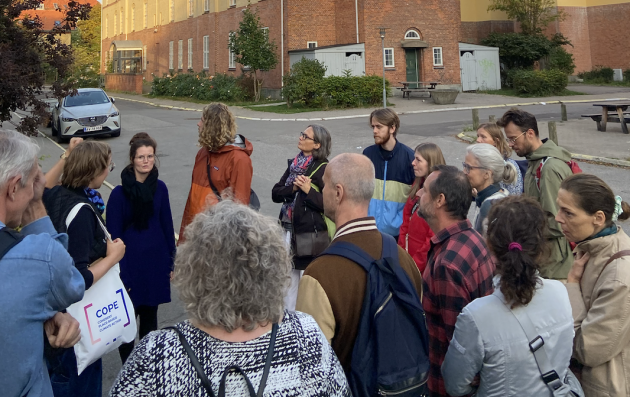Date of label : 29/10/2024
-
Copenhagen , Denmark
-
Size of city : 602.481 inhabitants

This image depicts a group of people gathered outdoors in what appears to be a parking lot or courtyard area.
Summary
The Climate Taskforce aims to bring the green transition to a local level by integrating citizen cooperation. The focus in Copenhagen (DK) is on making the transition an integrated part of urban renewal, and to strengthen the commitment of citizens to take climate action.
The solutions offered by the Good Practice
The Climate Taskforce fosters close cooperation with local communities and citizens to create green transition plans that can be implemented locally, and managed independently of the municipality. Its ambition is to enable citizens to take ownership of their green initiatives using diverse approaches.
Since 2021, four local climate officers have been deployed in Copenhagen to ensure green perspectives are included in urban renewal projects. They collaborate with local residents, for example, on creating shared waste solutions, establishing a local network for the annual Climate Action Day, on a climate ambassador course for vulnerable citizens, and ensuring the hiring of a climate employee at the start of each area’s renewal project. The climate officers serve as a link between top-down and bottom-up processes, facilitating green initiatives at both levels.
Building on the sustainable and integrated urban approach
The Climate Taskforce practice uses an integrated approach, addressing environmental, economic, and social dimensions, through both horizontal and vertical integration. A local climate officer in each of the renewal areas acts as a central point, integrating political objectives with community needs. In this way, top-down professional expertise combines with the work of local community groups.
Environmental: The integrated approach promotes energy-efficient solutions, such as installing solar panels, and reducing water and heat consumption.
Economic: The Climate Taskforce fosters a circular economy, for example, through repair cafés and facilitating easily transferable actions.
Social: The initiative helps establish green communities that strengthen bonds within neighbourhoods, with a focus on food, waste, and biodiversity.
Based on participatory approach
The Climate Taskforce prioritises citizen involvements. Local climate officers facilitate the participatory approach, through the green actions implemented in local area renewals, involving residents, associations, and businesses.
The participatory approach is also evident in the steering groups for area renewals, involving local residents, community organisers and local businesses, that help shape the area renewal plans, alongside the local climate officers.
Local stakeholders and the municipality work together through locally-hired climate officers, who provide information, facilitate local events, and encourge participation in a green community.
What difference has it made?
Climate Taskforce supports building owners who want to lower CO2 emissions when they maintain, renovate or transform their buildings. The local climate officer can guide them towards solutions and funds for energy-efficient renovation. For example, a total energy consumption reduction of 8.1 GWh was reported for such work in the areas of Bavnehøj and Sydhavnen. A climate officer can, over five years, reduce an area’s heating consumption by approximately 11%.
Local Climate Taskforce actions also include dialogue with local housing associations, to disseminate municipal offers, improve waste sorting, organise green communal dining, and create a caretaker network for energy-efficient building management.
Overall, the taskforce has a positive local impact through energy savings, waste sorting, biodiversity, green mobility, and food communities. Climate officers liaise directly with people on the municipality’s behalf, while also providing a feedback mechanism for citizen input to climate initiatives.
Why this Good Practice should be transferred to other cities
The Climate Taskforce practice is relevant for other cities, offering a model for a green and just transition that engages citizens in existing green policies and urban renewal projects. It aims to enhance the legitimacy of policies, build trust in institutions, and inspire organisational development in local government.
It is linked to Copenhagen’s Climate Plan 2025 and the municipality’s Technical and Environmental Administration vision for enabling its citizens to create a better city. However, the methodology is not dependant on these, and therefore can easily be transferred to other cities and adapted to suit their specific contexts.
One of the project’s methods is asset-based community development, which is transferable by viewing any neighbourhood from an existing resource perspective. The practice creates connections between existing organisational structures, without creating new departments. Other methods include urban space analyses and workshops.
With limited resources, cities can look to Copenhagen’s model for supporting a local green transition within existing organisational structures. The practice is being used across the different area renewal projects in Copenhagen Municipality, each have a climate officer assisting the citizens in the green transition, but it has not yet been transferred outside the municipality.
